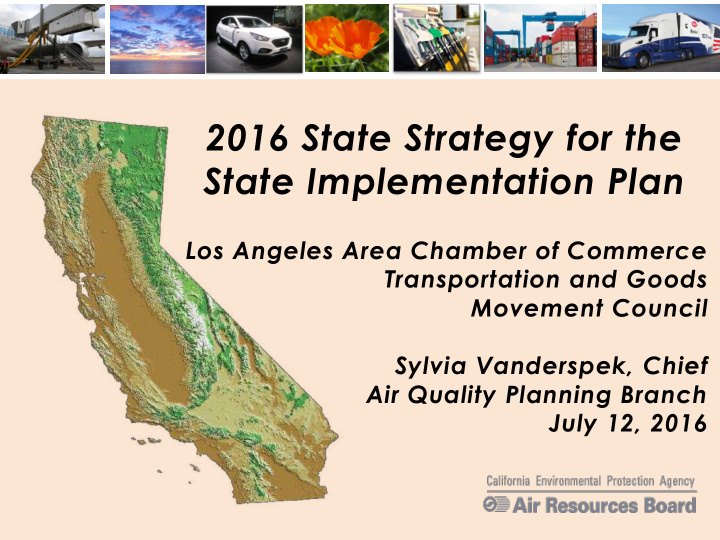



2016 State Strategy for the State Implementation Plan Los Angeles Area Chamber of Commerce Transportation and Goods Movement Council Sylvia Vanderspek, Chief Air Quality Planning Branch July 12, 2016
Mobile Source Reductions are Key • Largest contributor to smog-forming and diesel PM emissions and greenhouse gases o 80 percent of ozone-forming NOx Emission Contribution from Mobile o 50 percent of greenhouse gases Sources 100% 90% o 90 percent of diesel PM 80% All Other Sectors Emissions contribution 70% • Will require combination 60% Transportation Sector 50% of cleaner technologies, 40% fuels, and energy 30% 20% sources 10% 0% GHG NOx Diesel PM 2
Mobile Source Strategy On-Road Light-Duty Vehicles NOx Emissions in the South Coast (tpd) Mobile Source 90 • 80 Strategy integrates 70 86% reduction 60 climate and air quality 50 planning updated in 40 30 May 20 10 0 State SIP Strategy • 2015 2031 On-Road Heavy-Duty Vehicles represents the needs NOx Emissions in the South Coast (tpd) 160 to meet State 140 attainment 120 85% reduction 100 South Coast needs • 80 60 drive reductions 40 20 0 3 2015 2031
South Coast Attainment Needs • Fair share scenario - all sources need to be reduced by 80 percent in 2031from today • Mobile Source Share o Current program achieves over 50 percent of the needed share of reductions o With new rule commitments, over 80 percent of share of reductions are achieved o Remaining will be met through new regulations and incentives 4
Key Strategy Actions • Establish cleaner engine performance standards • Increase penetration of ZEV technologies • Ensure durability of emission control systems • Expand use of cleaner renewable fuels • Conduct pilot studies to demonstrate new technologies • Incentivize deployment of cleanest technologies 5
Establish Cleaner Engine Standards Low-NOx Engine Standard • Establish California standard effectively 90% cleaner than today’s o engines; petition U.S. EPA to establish federal standard More Stringent Locomotive Emission Standards • Petition U.S. EPA for federal Tier 5 standard and more stringent o requirements for remanufactured locomotives Tier 4 Vessel Standards • Advocate for more stringent IMO standards and efficiency targets o At-Berth Regulation Amendments •
Introduce ZEV Technologies: On-Road Advanced Clean Cars 2 • Increase number of ZEVs and PHEVs sold in California o Increase stringency of fleet-wide emission standards o Advanced Clean Transit • Continue transition of transit fleets to advanced clean o technologies Achieve benefits in disadvantaged communities and o maintain/expand service Last Mile Delivery • Phase-in of zero emission purchase requirements o Zero-Emission Airport Shuttle Buses • Develop approaches to increase penetration of zero o of zero emission technologies
Introduce ZEV Technologies: Off-Road Zero-Emission Off-Road Forklift Regulation • Increase penetration of zero emission technologies for forklifts with lift o capacities <8,000 lbs Transport Refrigeration Units Used in Cold Storage • Stationary run-time limitations o Increased operational efficiencies o Zero-Emission Airport Ground Support Equipment • Transition diesel and LSI equipment to zero emission technologies o Small Off-Road Engines • Establish more stringent exhaust and evaporative standards o Increase penetration of zero emission technologies o Technology Assessments for other off-road categories •
Ensure Engine Durability • Light-Duty Lower In-Use Performance Assessment o Joint assessment with Bureau of Automotive Repair o Evaluate in-use performance of OBD II systems • Heavy-Duty Lower In-Use Emission Performance Level o Develop supplemental actions to address in-use emissions and decrease engine deterioration • Innovative Technology Certification Flexibility o Provide regulatory flexibility for innovative technologies to expand hybrid and other advanced technologies in heavy-duty truck applications
Expand Use of Renewable Fuels • Low Emission Diesel Fuel o Replace 50 percent of diesel demand with low emission diesel by 2031 o Gradual implementation of strategy beginning in South Coast, then expanding statewide o Greatest emission reductions in off-road, legacy fleets
Further Technology Deployment Achieve further emission reductions for South Coast • attainment through a suite of additional actions including: NOx Emissions in the South Coast from Mobile Sources Further regulatory strategies o 600 based on initial technology Current Control Programs deployment 500 Cleaner Technology and Fuels Incentive programs for early o Scenario + Further Deployment penetration of zero and 400 NOx tons per day near-zero technologies 300 Increased operational o efficiency strategies 200 Use of connected and o 100 autonomous vehicles, telematics, and intelligent 0 2010 2015 2020 2025 2030 transportation systems
Implementation Schedule 12
Scope of Cleaner Technologies 2031 South Coast Passenger Fleet ZEV Population 2.9 Million PHEV Population 1.2 million Low-NOx truck population 430,000 Truck Fleet ZEV last-mile delivery truck 11,000 population
Economic Analysis • Analysis of economic impacts conducted using Regional Economic Models, Inc. (REMI) • Benefits: Broad environmental and health benefits • Costs: Strategy not anticipated to significantly impact California economy • Measures likely to change the way vehicles, fuels, and mobile equipment are manufactured, distributed, and consumed • Employment and production shifts within industries 14
Next Steps • Public comment period is open through July 18, 2016 • Workshops in summer 2016 • Board will consider State SIP Strategy in September 2016 • Region specific commitments are part of SIP • Measure regulatory process 15
Recommend
More recommend